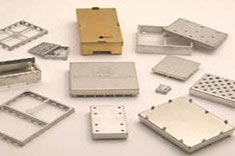EMI Shielding Products
- Custom Gasket Fabrication
- Connector Gaskets
- Bonded O Ring
- Custom Gaskets
- Conduct-O-Knit Knitted Wire Mesh
- Conduct-O-Seal Combo Gasket
- Conduct-O-Elastomer
- Conduct-O-Seal Oriented Wire in Silicone Gasket Material
- Conduct-O-Mesh Tape
- Conduct-O-Foam
- Conduct-O-Bond
- Optical Filters For Electronic Displays
- Shielded Vent Panels
- ESC Board Level Shielding
- 300 Series
How to Test the Effectiveness of RF Shields

RF (radio frequency) shields are designed to protect electronic devices from interference caused by RF signals. They are commonly used in devices such as mobile phones, laptops, and Wi-Fi routers, as well as in industrial and military applications.
The effectiveness of an RF shield is typically measured in terms of its ability to attenuate (reduce) the strength of incoming RF signals. This is important because stronger RF signals can cause more interference with the operation of electronic devices. Engineers and technicians use various mathematical equations and techniques to test the strength of an RF shield.
One common method for measuring the attenuation of an RF shield is the S-parameter test. This test involves measuring the transmission and reflection of RF signals as they pass through the shield. The S-parameters are calculated using a set of equations that consider the complex impedance of the shield, as well as the frequency and power of the RF signals.
Another method for testing the strength of an RF shield is the shielding effectiveness (SE) test. This test measures the reduction in the strength of an RF signal as it passes through the shield. The SE is calculated using the following equation:
SE = 10 * log10(Pin/Pout)
Pin is the strength of the incoming RF signal, and Pout is the strength of the RF signal after it has passed through the shield. The SE is typically measured in decibels (dB).
Several other factors can affect the strength of an RF shield, including the thickness and conductivity of the material used to make the shield, also the size and shape of the shield. Engineers and technicians must consider these factors when designing and testing RF shields to ensure that they are effective at reducing the strength of RF signals.
In summary, an RF shield's strength is evaluated using various mathematical equations and techniques, including the S-parameter test and the shielding effectiveness (SE) test. These tests measure the attenuation of RF signals as they pass through the shield and help engineers and technicians design effective RF shields for a wide range of applications.



